Hannah R. Goodman's Blog, page 6
October 24, 2017
Mindfulness: Hold Your Pain Like a Baby
I've practiced sitting meditation for years, and it was only when I committed to using HeadSpace for almost a full year, that I discovered why people meditate regularly—it really changes the way you deal and perceive generalized anxiety. For me, it helped me with the skill that I call making space or "holding pain like a baby".
The concept of making space first came to me from a therapist I had over 10 years ago. He was also the first person to introduce me to ACT, a type of therapy that is a little more philosophical and deeper than CBT. It is some really heady stuff but what I liked about this therapist is that he boiled down the concepts to two major points that I have used ever since: The first, I have written about previously, which is a concept I call " walking towards your values" . This is the idea that when faced with a lot of anxiety about a decision, you choose the thing that is in line with what you value, in your core. So, if you are trying to decide if you should continue to have a relationship with your father even though it is fraught with misunderstanding and poor communication you have to ask yourself what do I value in this situation? Do I value my relationship, even though it is difficult, with my father more than I value not having him in my life? If the answer is that you value the relationship more, then you can begin to figure out how to walk towards that value you in the least distressing way, in a way that doesn't then infringe on the value you have about your own well being or mental health. So that could mean I will maintain a relationship with my father but one with boundaries (ie. I will call on holidays and birthdays and visit once or twice a year). Walking towards your values has helped me make a lot of very big decisions in my life, around work and home-life, decisions that I can look back on and feel very good about, even though, in the moment working through the kinks of the decision may have been painful. In the example with the father, creating those boundaries can be emotionally difficult as unnecessary and unwarranted guilt may rise up...now here is where the making space or holding your pain like a baby comes into play. That guilt that you feel isn't due to actually having done something wrong or immoral, which is what guilt is for (and we misuse the term all the time for when what we really feel is simply bad about something). So this guilt is simply just emotional discomfort or even pain and therefore there is nothing to "do" with it...except let it be...allow...our tendency is to struggle with emotional pain—try to avoid or get rid of it. Instead, ACT (and Mindfulness) invites us to DO NOTHING and I think of this as hold the pain like you would a baby—with care, support, gentleness, and love.
The sitting meditation is an opportunity for us to do just that: as feelings of discomfort arise, hold it and be with it, as you would a tiny baby.
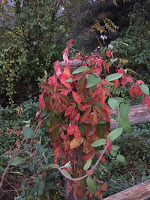 Today, I am spending it off from work and simply doing the Mindfulness homework (which I can incorporate with the chores and tasks of the day). As I notice both the pleasant experiences and log them, I allow also for any discomfort and I don't do anything but treat it with care and kindness. It reduces struggle and, best of all, anxiety.
Today, I am spending it off from work and simply doing the Mindfulness homework (which I can incorporate with the chores and tasks of the day). As I notice both the pleasant experiences and log them, I allow also for any discomfort and I don't do anything but treat it with care and kindness. It reduces struggle and, best of all, anxiety.This is not a cure-all. It's a way to live with, and not against, the mental stuff we all deal with at various times of the day.
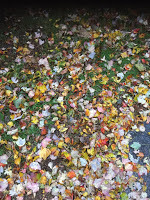 In that, my pleasant experiences are these tiny moments where I have rested into Mindfulness, whether it's noticing the breeze coming in through the window of my office and how it softly brushes my arms or kissing my daughters good morning and noticing how soft and still-newish their skin is.
In that, my pleasant experiences are these tiny moments where I have rested into Mindfulness, whether it's noticing the breeze coming in through the window of my office and how it softly brushes my arms or kissing my daughters good morning and noticing how soft and still-newish their skin is.So far, this course is giving me much more than I hope or expected...probably because I just went in with an open heart.
October 21, 2017
Mindfulness: Relapse and Recovery
To be frank, I'm pretty sure I've got some major PMS happening this week, and today it seems to be slamming into the walls of my mind. Anxiety is up...worrying is all-encompassing. Moments of peace have come only from my daily mindfulness assignments. Today's morning walk and body scan meditation were the only moments were the buzz of my mind was faint...
As I went about my day, working with students, managing my kids, doing some various chores, while engaged in each actual task, my mind was happy and the mind-buzz far away. It's the in between moments...when the task is done and I must transition or wait to begin the next thing that the worry and anxiety rage up like flames of a hungry fire...and I try so hard to tamp those flames out, but I'm pretty sure that I am doing something wrong because it doesn't work. And, because I'm both a therapist and a patient of therapy, I do know that tamping on anxiety doesn't get rid of it because it isn't a real fire.
I'm in a hard core transition period of my life...it's been a long and drawn out one, starting with turning 37 when I decided to return to school. Prior to 37, I hadn't really had a major bout with my anxiety since my early twenties.
In 2014, I had a HUGE relapse with my anxiety and it scared the absolute SHIT out of me. But I climbed out of it, and ultimately was in remission for almost 2 years when BAM! It returned. It's been back old-school style, circa 1992-1993, when I had my very first panic attack....a story that is about to be published by OC87 Recovery Diaries NEXT Wednesday (on my mother's 70th birthday, which, in and of itself, is kind of surreal. We lost my beloved grandmother just 6 weeks after she turned 70 and so that number is scary for me).
 The good part, however, is this relapse hasn't been all bad. I can manage it...sometimes better than others! This is why during this period of time I love mindfulness activities. I don't have to TRY....that is, if I allow myself permission to really just fall into the mindfulness and allow myself to not try to do it right or perfectly. Mindfulness brings some relief.
The good part, however, is this relapse hasn't been all bad. I can manage it...sometimes better than others! This is why during this period of time I love mindfulness activities. I don't have to TRY....that is, if I allow myself permission to really just fall into the mindfulness and allow myself to not try to do it right or perfectly. Mindfulness brings some relief. Since this is about mindfulness I want to stop for a moment and pause as I am aware of how good it feels to allow my fingers to fly across the keyboard and express the thoughts that are rolling through my mind as they roll through without editing or deleting.
Since this is about mindfulness I want to stop for a moment and pause as I am aware of how good it feels to allow my fingers to fly across the keyboard and express the thoughts that are rolling through my mind as they roll through without editing or deleting.As I conclude this entry about my 7th day of the mindfulness course, I reflect on yesterday's walk and today's walk. I took a picture of the same spot, different days and these pictures really reflect how I have been feeling lately...calm and then stormy...calm when in my mindful practice or engrossed in a task and then stormy in the in between moments...
October 19, 2017
Mindfulness and STRESS!
Yesterday my morning walk was distracted. I have some external stressors happening in my life...the kind of stressors that are not within my control, or at least not within as much control as I would like. Those type of stressors are always within the domains of family and work—what else is there in life that can cause a feeling within you of absolute powerlessness at times? When things that were seemingly going along well, all of the sudden—or so it seems—flip all upside down and you are left with WHAT THE HELL????
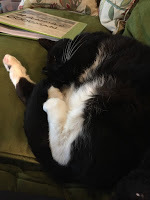 So, with this in mind, you can understand why taking this course is perfect timing in my life! It is also perfect that this mindfulness course I'm taking requires that you note and record one informal mindfulness exercise every day—whether it is eating something mindfully or taking a walk mindfully or even something as simple as sitting next to your adorable purring cat mindfully.
So, with this in mind, you can understand why taking this course is perfect timing in my life! It is also perfect that this mindfulness course I'm taking requires that you note and record one informal mindfulness exercise every day—whether it is eating something mindfully or taking a walk mindfully or even something as simple as sitting next to your adorable purring cat mindfully.So far, I seem to be doing my informal exercise on my daily morning walk. Yesterday morning, with all that is happening around me (those external stressors), I was pretty distracted on this walk, though not in an anxious way but more of a energized and let's-get-on-with-it way. Today, I felt more present on my walk and was able to really be mindful—take in the vibrant colors of the foliage, smell the sweet and pungent air of fall, and feel grounded in the strength of my stride as I walked (and the slight creaking of my hips!).
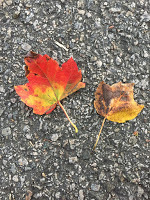 During my morning walks I always listen to talk radio (I know, probably not the most zen thing but everyone gets there zen in different ways—no judgment, right?) so for this mindfulness course, I am shutting off the show for about 3 minutes and intentionally noticing the space and scenery around me. Because of this time of the year, I noticed the leaves immediately. Yesterday I observed how different they are when not soggy from the rain, that they curl up more when dry. Today I noticed one tree with all maroon leaves and how the marron was actually made up of two different leaves with two different shades of the color.
During my morning walks I always listen to talk radio (I know, probably not the most zen thing but everyone gets there zen in different ways—no judgment, right?) so for this mindfulness course, I am shutting off the show for about 3 minutes and intentionally noticing the space and scenery around me. Because of this time of the year, I noticed the leaves immediately. Yesterday I observed how different they are when not soggy from the rain, that they curl up more when dry. Today I noticed one tree with all maroon leaves and how the marron was actually made up of two different leaves with two different shades of the color.Yesterday I also did the other daily assignment in the course, the body scan but this time I researched for another one that might be a little shorter. Check it out here. This one was soothing and quick. Exactly what I need in my life right now!!
Fall is about transitioning into a more internal state of winter and it seems to me that this particular fall has been filled with a lot of external challenges and obstacles in the path of change. Utilizing mindfulness, I can be in the moment and get brief periods of rest. Instead of riding the What If train, I float on the What Is boat!

To read about day 7, click here.
October 17, 2017
Mindfulness: FAILURE
Yesterday I attempted the body scan meditation again but with a different guided audio and... SUCCESS! What I mean is, I was able to do it without wanting to jump out of my skin, which was what I felt with the previous guided body scan because the guy's voice was HIDEOUS! Instead, I used this audio, which has the soothing sounds of Mindfulness guru John Kabat-Zinn.
Now my one critique of this mediation, in general, is that it is WAYYYYYY too long for folks like me whose temperament is more high energy/anxiety. I need a meditation that is engaging (mindful) yet not more than 25 minutes MAX. This ran 29 minutes. I stopped at 25.
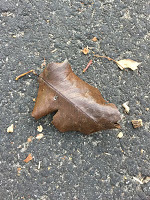 What I am beginning to see and understand about myself is that I carry perfectionism into all areas of my life, to a detriment. I was judging myself and also arguing with myself internally for not "doing it right", meaning...when I did this yesterday, I was at work and couldn't exactly sprawl out on the floor of my tiny office, so I sat back in my chair. The body scan directions state that you should recline...so I got all over myself about that. The arguing part was me yelling at myself that this was "Probably a waste and how many times have you attempted to create a lasting meditation practice?" and "You just suck at this!" and on and on. The antidote to this was...mindfulness. Meaning, I noticed what I was doing to myself, and I didn't try to reason back, necessarily, but more "note", which is something I learned in my own studies of mindfulness over the years. I've practiced noting throughout my journey with chronic anxiety, and it always brings peace and helps me to let go of that which I cannot control, mainly where my messy and creative mind can wander. I also argued with myself about stopping at the 25 minute mark...what happened was I naturally felt "done". The mediation guided me to scan and breathe into all parts of my body so when I reached the last part, I opened my eyes and was done...but the audio kept going, so I automatically was like, "Loser! You can't even finish this or be patient enough to listen for another few minutes."
What I am beginning to see and understand about myself is that I carry perfectionism into all areas of my life, to a detriment. I was judging myself and also arguing with myself internally for not "doing it right", meaning...when I did this yesterday, I was at work and couldn't exactly sprawl out on the floor of my tiny office, so I sat back in my chair. The body scan directions state that you should recline...so I got all over myself about that. The arguing part was me yelling at myself that this was "Probably a waste and how many times have you attempted to create a lasting meditation practice?" and "You just suck at this!" and on and on. The antidote to this was...mindfulness. Meaning, I noticed what I was doing to myself, and I didn't try to reason back, necessarily, but more "note", which is something I learned in my own studies of mindfulness over the years. I've practiced noting throughout my journey with chronic anxiety, and it always brings peace and helps me to let go of that which I cannot control, mainly where my messy and creative mind can wander. I also argued with myself about stopping at the 25 minute mark...what happened was I naturally felt "done". The mediation guided me to scan and breathe into all parts of my body so when I reached the last part, I opened my eyes and was done...but the audio kept going, so I automatically was like, "Loser! You can't even finish this or be patient enough to listen for another few minutes."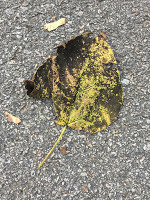 I am SOOOOOOO MEAN to myself and it's ANNOYING, ALREADY!!!! I'm 4 effing 2. This needs to friggin stop....
I am SOOOOOOO MEAN to myself and it's ANNOYING, ALREADY!!!! I'm 4 effing 2. This needs to friggin stop....However, what mindfulness is trying to show me is that I can NOTE and OBSERVE that I do this to myself and in that noticing, I can create space and step back from the judging and yelling and see it for what it is, which is simply my fight or flight bullshit I automatically do because of my anxiety temperament. I'm just trying to protect myself against what I perceive is the enemy and that is: failure.
What I have to remind myself of is that failure isn't the enemy. Failure is the teacher, the tutor, the education....it contains critical information about what I really value.
 What I value and what all my many, many failures have taught me is that I am a seeker and a doer and as long as I am seeking and doing, I am fulfilling my purpose.
What I value and what all my many, many failures have taught me is that I am a seeker and a doer and as long as I am seeking and doing, I am fulfilling my purpose.Right now, I'm at the top of a mountain...a place I was 7 years ago, though that was a different mountain; it was a mountain of a life dream achieved. I had completed my MFA and a collection of short stories that were the creative result of the pain I went through in high school.
Now, I've climbed another mountain and achieved my other life dream of becoming a licensed pychotherapist, and the bonus of this moment is that my own mental health journey is about to be published in an essay I wrote for OC87 Diaries...bittersweet.
You would think that my anxiety right now was nil. Gone. Nada.
And you would be very wrong. I'm having tremendous anxiety about—you guessed it—failing.
When you are at the top of the mountain, you have nowhere to go but back down...and I fear that.
My hope is that mindfulness will keep me in this moment, however difficult it is, but that if I am present I can stop worrying about "What if I fail?".
Read Days 5 and 6, here.
October 15, 2017
Trying NOT to HATE Mindfulness
I just did it for the first time, and I HATED IT! Every minute of it was AGONIZING. I've done similar meditations before and haven't felt this way. It felt too long, the voice wasn't soothing, and my mind kept going all over the place because I felt so BORED and DISCONNECTED.
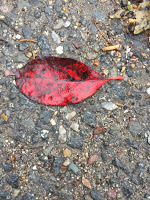
 The workbook says, "Don't expect to feel anything in particular from this practice. In fact give up all expectations about it."
The workbook says, "Don't expect to feel anything in particular from this practice. In fact give up all expectations about it."Is it possible that I had an expectation? Probably. I expected NOT TO HATE IT SO MUCH THAT THE THOUGHT OF DOING IT AGAIN MAKES ME WANT TO SCREAM AND RUN.
Interesting to me is how much more mentally anxious I feel since starting this course. I know I am not supposed to have an expectation but how about a "hope", as in, "I hope this gets better!
Maybe I am that one small percent of the population that actually responds the opposite to Mindfulness practices...
We shall see.
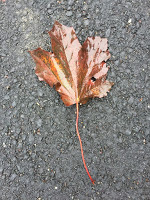
The other thing I am to do each day this week is bring mindful awareness to some otherwise routine activity. So on my daily walk this morning, I paid close attention to the leaves. I found their colors to be soothing and beautiful and interesting. I liked this exercise. This one didn't make me feel CRAZY.
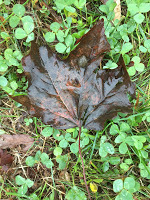 I am committed to seeing this thing through because all of the research does support that Mindfulness training reduces stress and helps a lot of chronic conditions both mentally and physically. So far, I'm not loving it and not seeing how it will make much of a difference...I've studied Mindfulness on and off since I was a teenager but never formally, and I do worry that this formal approach will kill it for me; yet I know that this can only happen if I do the thing that all Mindfulness teachers say NOT to do and that is put expectations on this experience. I think that the expectation I have is that I will do every single assignment perfectly and exactly how it should be...I am realizing that I have gone into this with a non-mindful attitude—outcome oriented. In one of the videos I watched this week called "Don't Try to be Mindful" by Daron Larson, he says to "stop focusing on outcome" and yet that's all I am doing. I know that there is a certificate to be earned at the end of this course and that's all I see in my head. If I do this all correctly, I will get a prize and then I am something, I am somebody, I am important.
I am committed to seeing this thing through because all of the research does support that Mindfulness training reduces stress and helps a lot of chronic conditions both mentally and physically. So far, I'm not loving it and not seeing how it will make much of a difference...I've studied Mindfulness on and off since I was a teenager but never formally, and I do worry that this formal approach will kill it for me; yet I know that this can only happen if I do the thing that all Mindfulness teachers say NOT to do and that is put expectations on this experience. I think that the expectation I have is that I will do every single assignment perfectly and exactly how it should be...I am realizing that I have gone into this with a non-mindful attitude—outcome oriented. In one of the videos I watched this week called "Don't Try to be Mindful" by Daron Larson, he says to "stop focusing on outcome" and yet that's all I am doing. I know that there is a certificate to be earned at the end of this course and that's all I see in my head. If I do this all correctly, I will get a prize and then I am something, I am somebody, I am important.Right now, I don't know how to stop thinking that way but I do know that a mindful teacher would say, "Do nothing. Notice. Allow. Let." Notice the expectation. Notice the judgment. Notice the anger and self loathing in this and then keep going. Do this course because you value the process and along the way ACCEPT that you most likely will be kicking and screaming and fighting...and at some point, you will probably not do those things, but for now, you are and that's OKAY.
To read about Days 3 and 4, click here.
October 14, 2017
Mindfulness Training
If you'd like to join me, click here for the course.
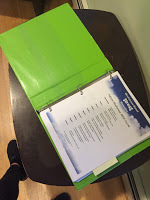
 I've downloaded and assembled the workbook and watched the required videos for week 1, commencing with an exercise of mindfully eating a raisin, which I didn't have in my pantry so I cut up a date into very tiny pieces. It worked, sort of. The exercise actually depressed me because he takes you through a sensory experience, which includes thinking about the life and death of the raisin (he uses the word umbilical cord to describe the part of the raisin where you can see a teeny tiny stem from when it was a grape). He also talks about the laborers who picked and dried the raisin...then he invites you to eat it slowly...
I've downloaded and assembled the workbook and watched the required videos for week 1, commencing with an exercise of mindfully eating a raisin, which I didn't have in my pantry so I cut up a date into very tiny pieces. It worked, sort of. The exercise actually depressed me because he takes you through a sensory experience, which includes thinking about the life and death of the raisin (he uses the word umbilical cord to describe the part of the raisin where you can see a teeny tiny stem from when it was a grape). He also talks about the laborers who picked and dried the raisin...then he invites you to eat it slowly...
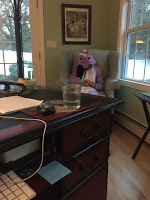
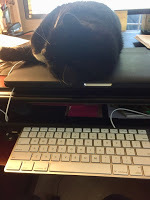
So far though, I’m into this and only dreading the silence and boredom of meditating…I’ve tried for years to commit to a meditation practice only to wind up bored out of my mind…or continually interrupted, as I am right now, by my children and/or cat.
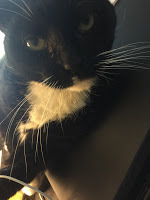 I have to sign off now. The cat is sitting on my lap top and the oldest child has entered my office in her unicorn pajamas.
I have to sign off now. The cat is sitting on my lap top and the oldest child has entered my office in her unicorn pajamas. Stay tuned for my adventures in Mindfulness.
September 4, 2017
The What-If Game
Recently I discovered a file marked "Media: 2003-Present", except it clearly doesn't contain anything from the present as most of the articles I found make bold exclamations about my rising career as a self-published author—my "present" couldn't be further from that reality. Despite my lack of success at becoming the next Judy Blume, these articles do reveal what my life was like during this period of my time, and they contain so much hope and enthusiasm it is hard not to get caught up a little in the what-if game (come on, you play it, too!). Now that I am two years into my forties, I can look back with detachment and even a little awe—I did accomplish a lot for a nobody-writer. So even if those dreams didn't come true, they are fun to remember.
Below are some of my favorite articles about that initial dip into local celebrity...
The Wave, November 2003
 What is particularly funny to me about this is that basically the writer is questioning my sanity...which, looking back, makes a lot of sense!
What is particularly funny to me about this is that basically the writer is questioning my sanity...which, looking back, makes a lot of sense!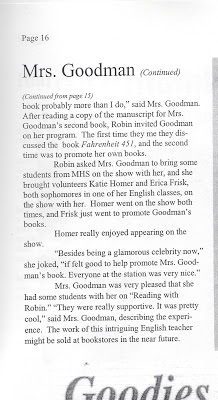
Really, things were looking hopeful and promising...the New York publishers were calling...Also, I was VERY pregnant in this picture.
Some time between April and June, 2004.
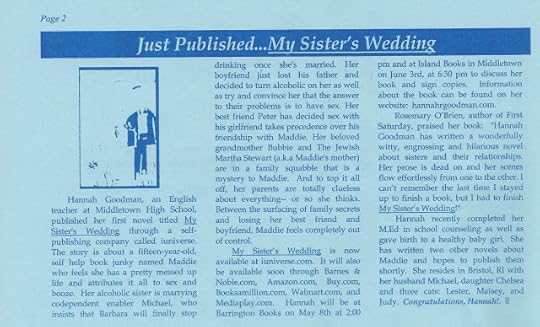
Now this is a little newsletter from the school district I last taught in...shocking that they refer to the characters having sex! Don't think this would happen today!
June,1 2004, Newport Daily News
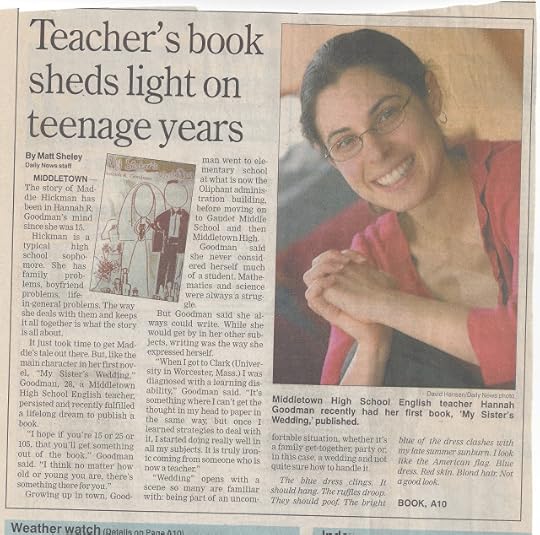
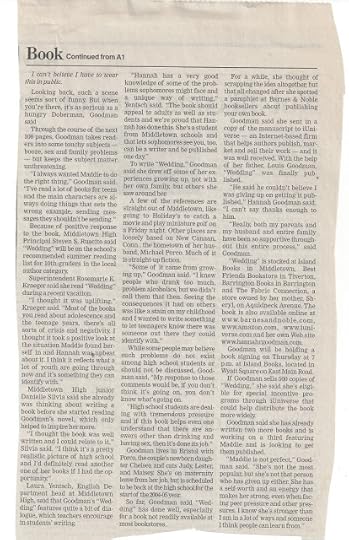
What's great about this article is how my superintendent READ the book and my principal put it on the summer reading list. Very cool. The reporter made me feel like a celebrity. I mean I was on the front page of the paper, so come on!
The Jewish Voice & Herald, May 28, 2004
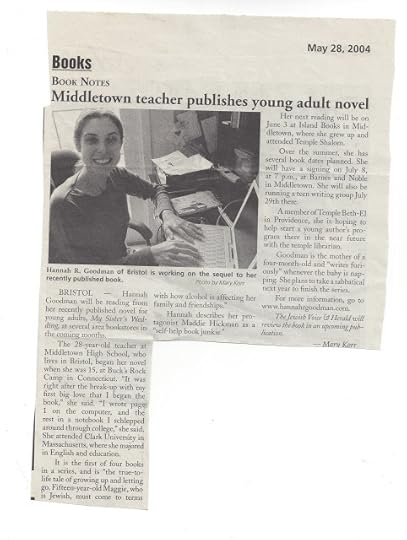 Probably what I like the most about this article is that they call the main character "Maggie" instead of "Maddie". Oh, well.
Probably what I like the most about this article is that they call the main character "Maggie" instead of "Maddie". Oh, well.April 13, 2005, The Providence Journal
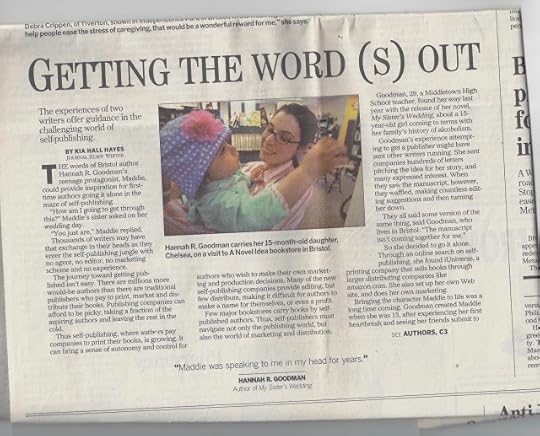
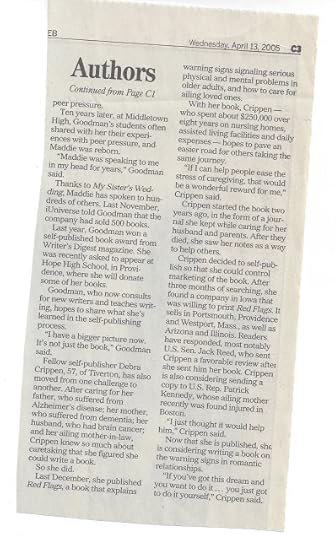 I was particularly proud of this piece in The Providence Journal because they had been rejecting me for awhile when I sent them the first press release. This felt like a real victory to me.
I was particularly proud of this piece in The Providence Journal because they had been rejecting me for awhile when I sent them the first press release. This felt like a real victory to me.
Writer's Digest, 2004
Though this is a very small blurb, seeing the words "first place" next to my very first novel was really the best moment for me. After that, no other accolades about my novels really could compete.
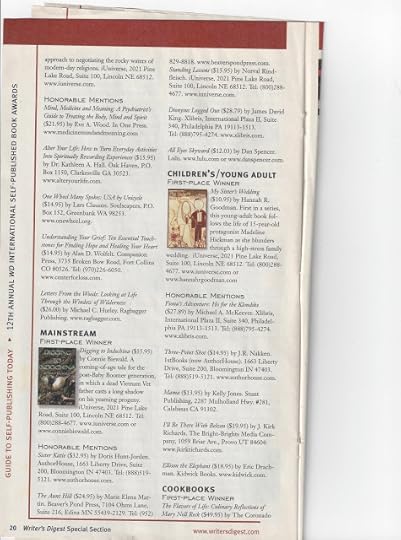
KLIATT, January 2005
And...my first review! This appeared in KLIATT, which is no longer in print but at the time was a pretty big deal!
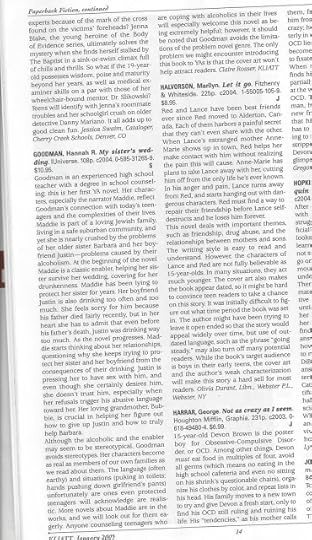
November 4, 2016
A Pause
Throughout my journey as a writer, I’ve experienced waves of inspiration, as I’m certain all of you have, too. I’ve been surfing the waves of inspiration to write YA stories since I wrote my first one when I was 15. A version of that is here, in case you are curious. Wave after wave came easily for a little over two decades, long past my own teen years.
Recently, as I’ve experienced some changes in my career (I’m finishing up coursework and clinical hours to become a licensed mental health counselor), those waves of inspiration to write YA have waned. Over the last year or so, the awesome grinder I once rode was coming to shore crumbly. Eventually, there were no waves to ride.
I’ve begun to feel the swells of new inspiration to write something new, something connected to mental health, something more personal. I’ve begun a project that isn’t fully developed yet and that I’m more kicking around. If you are interested in taking a peek at this, click here.
Writing young adult fiction started off as therapy for me because my teen years were terrifying, exciting, exhausting, and, most of all, inspiring. I wrote to make sense of the confusion that is the hallmark of this time period. Similarly, I feel that what I am now interested in writing about is also connected to making sense out of something—now it’s emotional health and wellbeing. Story telling is a critical part of this, and I’m interested in following this new wave of inspiration.
So, that brings me to the real purpose of this post: After much thought and discussion, I, along with my sisters-in-writing, Steph Keyes and Kacey Vanderkarr, have decided that we will be closing the doors of this blog for a little while. As of right now, we will be returning next summer, 2017.
This blog has been a healing salve for me; when we began, I was on the verge of book deal…or so I thought. You have all been with me as I dealt with failures and tried to redefine myself as a writer and author. The support and encouragement were lifelines for me, personally, and I hope they were lifelines for all of those out there who have encountered the inevitable failures that go along with attempting to get a book deal.
What sets us apart from other writing blogs is that we always discuss the personal…even when we talk shop or craft, my mission is always to share the personal aspects of this journey in publishing. I hope that while we are gone, you all continue to share your stories around the proverbial water cooler and meet us back here next year.


October 27, 2016
For Librarian Writers: How I Find and Maintain Creativity and Brain Space
“Wow, you’re a librarian, huh? Do you get to read a lot?”
What an old, tired question. I can already hear the collective sigh from other librarians reading this, because the truth is, librarians don’t get a lot of opportunities to read at all. In fact, when I was reading a book on a new arrivals cart, a colleague snapped, “Are you reading?” I put the book back like it was a half-eaten cookie from a jar and said, “No…..?”
If I’m being honest, I became a librarian because I wanted to be a writer, but the reality is, libraries have a lot less to do with writing and books than people think–and writers juggling both careers have a lot of day-to-day challenges that can often feel like a candle burning at both ends.
The Day Job Minutia
In my experience, librarians, by nature, tend to make things more complicated than they need to be, which tends to make work days drag. It can often feel like being stuck in traffic slow enough to see cows peeing. I’ve walked past research consultations in which the student (or patron, or whoever) is staring up at the ceiling while the librarian talks, and looking like they’d asked for directions and ended up in the wrong part of a bad neighborhood. I’ve also been in meetings where we spent a half hour trying to tweak a policy sentence to sound just the right way. And with enough hours like that, coming home to write creatively feels like a very tall job indeed.
This isn’t to say that librarians are bad people; the majority of the ones I’ve worked with have been great. And, like a lot of other jobs, librarians are part of a leaner workforce, and it’s not uncommon to for one person to do the job of two or three people. But this can create a sense of helplessness among librarian writers, because like any writer with a day job, they can often feel like they don’t have enough energy to devote toward their creativity. It’s also probably they aren’t always forthcoming about their creative pursuits, especially in workplaces where it feels like their every move is being monitored.
The Five Hindrances
Every day, like many people, I was confronted with the conundrum of whether I was meant for something else. That even though I was good at librarianship, there was this gaping hole, a piece of me that got lost amid the static. Some days, the only thing that kept me going was my writing, and the hope that came with it. That, and an Emily Dickinson quote on my bathroom wall: “Dwell in possibilities.”
Another way I’ve found to help eliminate the forces dragging me backward is conquering what are known as The Five Buddhist Hindrances. This philosophy posits that everyone has a pristine pool within–and the Five Hindrances disrupt it. The Hindrances are mentioned in relation to meditation, but they can be applied to most situations.
Hindrance 1: Desire for what you don’t have
Or, the “if only” syndrome. If only I was a published writer, or if only I could get the hours in the day to hone my craft, or if only…blah blah blah my life would be better/different/tolerable. In my librarian career, I was plagued with these if-onlys–and most of them involved having more time to write.
I realized, though, that I had more control over this than I thought, and that the real answer lay in finding satisfaction at what I did throughout my day and taking pleasure in my accomplishments while striving for something greater. And if I didn’t get as much done as I’d wanted (which was usually always the case) I could keep striving a little bit each day. Kind of like eating an elephant. A little bit at a time.
Hindrance 2: Anger or ill-will
I also didn’t want to become like some other librarians I’d worked with who had resentment oozing out of their pores. Like any profession, some people have been stuck for so long that they take out their bitterness on others; I quickly found that being surrounded by a bunch of external vitriol can often get invasive. The best way to get past it was to recognize it, be with it, and move on. I had to think of other people’s negativity like a hot potato. I could briefly touch it, but let it go before it burned me.
Maintaining a sense of hope amid the deluge is necessary, not only for well-being, but for overall creative drive. Even more importantly, writing can help maintain a sense of self outside the day-to-day shenanigans.
Hindrance 3: Sloth/torpor
I think this is stops a lot of writers from cranking out material, even when they want to keep writing. Sometimes it comes in the form of exhaustion after a long workday. It’s okay to take breaks, but if one month turns to two without writing, try to find some motivational tools to help you get back in the game. Maybe start small–500 words written by sundown, or something along those lines. Or, carve out a set amount of hours during the day to write, edit, or do whatever else you can to reach your writing goals. For example, I started getting up at 6:00 AM to write because I wanted ensure my manuscripts were handled with my freshest brain. Do what works for you.
Hindrance 4: Restlessness/worry
I’m probably the most guilty of this one. If Hindrance 1 involves “if only”, Hindrance 4 is the “what if” syndrome. For example, I wrestled with having to fill my brain with librarian stuff rather than making room for the kind of creativity I wanted. This usually came with the usual writer worrier questions, like: What if my work isn’t good enough? What if I never get published?
These worries were usually unfounded, of course. I found plenty of ways to get published in nonfiction during my librarian career, and my writing improved the more I did it. It’s all in figuring out whether to put brain energy into worrying, or actually getting tasks done.
Letting go of restlessness and worry also involves recognizing the things in life beyond our control, and accepting them as they are. Take your challenges one day at a time, and keep moving forward even when it feels like the world is trying to pull you back. Write because you love it, and don’t concern yourself with the rest.
Hindrance 5: Doubt
You might ask yourself if writing is what you should be doing, especially when library work is pulling you in a bunch of different directions. For me, it became clear early on that I couldn’t not write. So I managed what I could, when I could, and it eventually helped establish a sense of purpose amid the chaos. Writing was something that was mine, that I could decide, when every other part of my day was spent doing what other people wanted me to do.So hold on to what’s yours, and seize it.
My hope is that no matter where you are, you can still maintain a sense of wonder in your writing journey. Or, as SFGate columnist Mark Morford says, “…being so deeply present, so connected, so alive, so pulsing and breathing and awake in the moment you are in that no matter what your job status, kid status, celebrity status, no matter where you live or to whom you are married, life is already full to bursting.” Make your stories. Craft your words. Shake your fists. But most of all, keep writing. Keep making. And keep doing. You’ll make it.
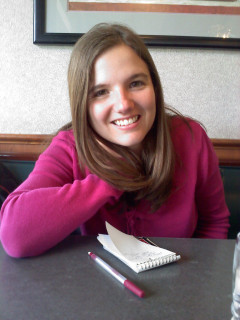 Outside her librarian career, Karen McCoy has written full-time since 2008, including reviews, book chapters, short stories, and an article for School Library Journal. She also maintains a blog, The Writer Librarian, where she interviews one author a week.
Outside her librarian career, Karen McCoy has written full-time since 2008, including reviews, book chapters, short stories, and an article for School Library Journal. She also maintains a blog, The Writer Librarian, where she interviews one author a week.
You can find out more about her on karenmccoybooks.com and view her writing portfolio at karenmccoy.net.
Websites: karenmccoy.net and karenmccoybooks.com
Twitter: @WriterLibrarian
Tumblr: @karenmccoybooks


October 20, 2016
Am I Too Privileged To Write Diverse Books?
Hi! I’m Joy. I’m a white, cisgender, straight, college-educated, Christian, physiologically and neurologically typical woman of suburban, middle-class background. I write young adult and children’s fiction. And I’m part of a problem.
The young reading audience in the United States is more diverse than ever. As of 2014, almost half of children in the US were not white, but in 2015 only 10 percent of children’s book authors and 14 percent of children’s book characters were non-white.
I write young adult and children’s fiction. And I’m part of a problem.
And it’s not just racial diversity that’s lacking in our books. Diversity can be invisible—like sexual orientation, gender identity, or socioeconomic background—or difficult to classify, like physical or intellectual disabilities.
But why do we need diversity in children’s books?
My older son is three years old. He has hazel eyes, a great Cookie Monster impression, a love of picture books, and Down syndrome.
How many children’s books do you think feature a character with Down syndrome?
Scratch that. How many children’s books that aren’t about Down syndrome do you think feature a character with Down syndrome?
(Spoiler alert: not many.)
My older son is three years old. He has hazel eyes, a great Cookie Monster impression, a love of picture books, and Down syndrome.
Education scholar Rudine Sims Bishop coined the metaphor of mirrors and windows to explain the need for diversity in children’s literature: “When children cannot find themselves reflected in the books they read… they learn a powerful lesson about how they are devalued in the society of which they are a part.”
Furthermore, according to Bishop, children from “dominant social groups” need diverse books to serve as “windows” to the varied backgrounds and perspectives of our world.
My younger son, who is four months old, does not have Down syndrome. He’ll have mirrors in every book he reads. But as they grow, both my sons should be able to find mirrors in books.
Books are a central part of our family life. What kind of message am I sending to my children about their equality in society if any “Down syndrome books” on our shelves are few, far between, and only focus on having Down syndrome?
My younger son, who is four months old, does not have Down syndrome. He’ll have mirrors in every book he reads. But as they grow, both my sons should be able to find mirrors in books.
All children deserve relatable, well-written characters that represent mirrors of themselves, as well as windows into perspectives they might not otherwise see. Kids should be able to find books that show them the ways in which they are different as well as the same.
After all, books are supposed to make us smarter, right? Shouldn’t they also make us more empathetic and compassionate? Shouldn’t stories open our eyes to new ways of seeing the world? And if not in childhood, when?
Well, I’m checking “majority” boxes for pretty much the whole diversity column. And following the mantra “write what you know,” the protagonist in my debut novel is a mirror of my fifteen-year-old self.
So how can I write diverse stories for young adults and children, without getting bogged down in cringe-worthy quagmires of political correctness and awkwardly “inclusive” language?
In other words, am I just too privileged to write diverse children’s literature?
No. And here’s why:
Privilege in itself isn’t the problem. Lack of awareness of privilege is. And as a majority-everything writer, I have a responsibility to remain aware of how my background and demographics pervade my writing. I don’t need to scour and scrub my privilege out of everything I write for the sake of being “diverse,” but I do need to remember that I want to write for every kid—and I want every kid to be able to connect positively with my work.
Privilege in itself isn’t the problem. Lack of awareness of privilege is.
To accomplish that, I’m reading more books about and by people who are different from me. And when I write, I’m consciously widening my focus from how my characters look, talk, and behave to richer questions: where they come from, who they love, if and how they pray, how they see the world, and how the world sees them. Here are some other things I’m keeping in mind:
Recognizing when I’m writing “mirrors” of myself and considering ways to open new “windows” instead
Writing without assuming I understand experiences that I haven’t lived through
Approaching unfamiliar ground with humility, knowing that mistakes mean I’m growing as a writer (and as a human)
Developing characters that are purposeful and complex
Focusing not on checking diversity “boxes,” but on broadening my own perception of who belongs in my stories and how
In short, I’m continually learning to treat characters (and readers) the way I’d want to be treated: like every part of who I am matters.
As a person of privilege, I’m part of an existing problem. But if, as a writer, I keep opening windows, I can also be part of the solution.
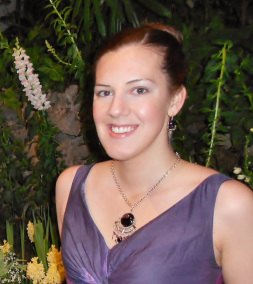 Joy Givens is the author of the young adult novel Ugly Stick and its companion collection April’s Roots, and she’s the co-author of The New SAT Handbook. Joy prefers to write middle grade and YA novels, leaning towards the fantastical and fabulous.
Joy Givens is the author of the young adult novel Ugly Stick and its companion collection April’s Roots, and she’s the co-author of The New SAT Handbook. Joy prefers to write middle grade and YA novels, leaning towards the fantastical and fabulous.
Born and raised with four siblings in Columbus, Ohio, Joy now resides in Pittsburgh, Pennsylvania, with her fantastic husband, their two remarkable sons, and an impossibly lovable dog. In addition to her writing, Joy is the owner and lead tutor of Givens Academic and Preparatory Tutoring, a company serving the greater Pittsburgh area. She also enjoys singing and listening to most genres of music, cooking for family and friends, and curling up with a good book and good coffee.
—





